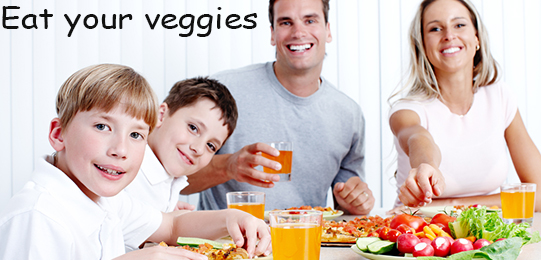
Ten Food Statements You Should Never Make to Your Children
As parents, we all say things to encourage our kids to eat healthier. Yet in our modern, food-centric environment, even well intentioned comments can be translated into negatives that hinder eating.
Here are 10 common “food statements” parents often say to kids; how they are likely to interpret this information; and more effective things to say and do.
1. “See, your (sister, brother, cousin, friend) is eating it, why don’t you?”
Your child thinks: “He/she is a better eater than me.”
A better thing to say: “I know you’ll get there, Sweetie. It takes time and many tastes to learn to like a new food.”
Instead of feelings of inferiority, you want to instill confidence that the child can and will like the food in his/her own time.
2. “You used to like blueberries. You are so picky!”
Your child thinks: “Maybe I won’t grow out of this picky-eating thing?”
A better thing to do: Don’t call attention to picky eating. Instead, make eating an enjoyable experience.
Avoid labeling children as “picky,” as this is a normal stage of development and the label tends to stick.
3. “For the last time, no, you cannot have ice cream!”
Your child thinks: “I’m never getting ice cream again!”
A better thing to say: “We are not having ice cream now because lunch is a half hour away. We’ll have some one day this week for dessert.”
Children accept ‘no’ much better when they know why they can’t have it and when they will have it again.
4. “You didn’t eat enough. Take a few more bites and then you can leave the table.”
Your child thinks: “Mom/Dad/empty plate (external signals) are a better judge of when I’m done eating than what I’m feeling inside.”
A better thing to say: “Make sure you get enough to eat because the next meal won’t be until breakfast/snack/lunch./dinner.”
When children are in charge of how much to eat, they learn how to effectively manage hunger.
5. “If you eat some of your veggies, you can have dessert.”
Your child thinks: “I can’t wait until the day I don’t have to eat my veggies and can go straight to dessert!”
A better thing to do: Instead of nagging and food rewarding, offer tasty vegetables often and model healthy eating.
Research shows that children learn to prefer the “reward” food over the “have to eat” food.
6. “Good job!” (after eating more than usual)
Your child thinks: “Mommy and Daddy are proud of me when I eat more food or finish my plate.”
A better thing to say: “You always do a good job eating when you listen to your tummy.”
Praising children for eating more food teaches them quantity is preferable to following one’s appetite, which varies from meal to meal.
7. “Eat this, it’s good for you.”
Your child thinks: “It tastes bad.”
A better thing to say: “This tastes really good and is similar to X that you like.”
Studies show taste rules children’s food preferences and they benefit from getting more information about a new item.
8. “If you are good in the store, you can have a cookie” or, “If you don’t stop doing that, you won’t be getting ice cream tonight!”
Your child thinks: “Every time I’m good, I should get a treat!”
A better thing to do: Let them know ahead of time the consequence that will happen if they misbehave — and leave food out of it.
Think about the long term effects of constantly rewarding with food. For example, in a 2003 study published in Eating Behaviors, adults who remembered food being used to reward and punish were more likely to binge eat and diet.
9. “We don’t eat cake often because it is bad for you.”
Your child thinks: “I like everything that is bad for me.” (Bad = pleasure)
A better thing to say: “Cake is not a food we eat all the time. We’ll have some cake this weekend at Jake’s birthday party.”
Labeling food as “good” and “bad” creates judgment around eating. Instead, teach children how all foods fit into a balanced diet based on frequency of eating.
10. “You don’t like dinner? Want me to make you something else?”
Your child thinks: “I never have to venture out with food because Mom/Dad will always make my favorites!”
A better thing to say: “We all get the same meal for dinner, sometimes you get your favorite and other nights someone else does.”
Eating meals together teaches children that eating is a family affair, and can encourage them to accept a wider variety of food over time.
Never underestimate the power your words have when it comes to children and food.
Maryann Tomovich Jacobsen, MS, RD, is the mother of two, and a registered dietitian. She co-created “The Fearless Feeding Community” in preparation for her first book, due out next year. Maryann is also the founder and creator of Raise Healthy Eaters, a popular blog about family nutrition.